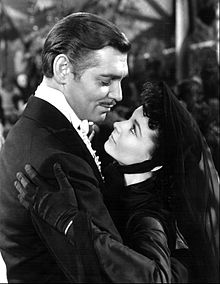It was a great time for Hollywood. The films had exciting new actors. Spencer Tracy. Bette Davis. Katharine Hepburn. The young Shirley Temple. The most famous film of the period was "Gone with the Wind" with Clark Gable and Vivien Leigh in the starring roles of Rhett Butler and Scarlett O'Hara. "No, I don't think I will kiss you, although you need kissing badly. That's what's wrong with you. You should be kissed, and often, and by someone who knows how." "Oh, and I suppose you think you're the proper person." "I might be. If the right moment ever came." Directors in the nineteen-thirties also produced such great films as "It Happened One Night," "Mutiny on the Bounty," and "The Life of Emile Zola." The success of radio and films, as well as the depression itself, caused problems for many Americans newspapers during the nineteen-thirties.
The trouble was not so much that readers stopped buying newspapers. It was that companies talked about their products through advertisements on radio instead of buying advertising space in newspapers. "Another cup of Maxwell House coffee, George?" "Sure, pour me a cup, Gracie." "You know, Maxwell House is always good to the last drop." Nearly half of the nation's independently-published newspapers either stopped publishing or joined larger companies during the nineteen-thirties. By World War Two, only one hundred-twenty cities had competing newspapers. Weekly and monthly publications faced the same problem as daily newspapers -- increased competition from radio and films. Many magazines failed. The two big successes of the period were Life Magazine and the Reader's Digest. "Life" had stories for everyone about film actors, news events, or just daily life in the home or on the farm. Its photographs were the greatest anywhere. Reader's Digest published shorter forms of stories from other magazines and sources. Most popular books of the period were like the films coming from Hollywood. Writers cared more about helping people forget their troubles than about facing serious social issues. They made more money that way, too.

But a number of writers in the nineteen-thirties did produce books that were both profitable and of high quality. One was Sinclair Lewis. His book, "It Can't Happen Here," warned of the coming dangers of fascism. John Steinbeck's great book, "The Grapes of Wrath," helped millions understand and feel in their hearts the troubles faced by poor farmers. Erskine Caldwell wrote about the cruelty of life among poor people in the southeastern United States, and James T. Farrell and Studs Terkel wrote about life in Chicago. The same social concern and desire to present life as it really existed also were clear in the work of many American artists during the nineteen-thirties. Thomas Benton painted workers and others with strong tough bodies. Edward Hopper showed the sad streets of American cities. Reginald Marsh painted picture after picture of poor parts of New York City. The federal government created a program that gave jobs to artists. They painted their and creativity to millions of people. Indeed, we are proud to have, in the lobby of our VOA building, several such murals by artist Ben Shahn, capturing many facets of the American experience in the nineteen thirties.
At the same time, photography became more important as cameras improved in quality and became smaller and more portable. Some photographers like Margaret Bourke-White and Walker Evans used their cameras to document the difficult conditions of the Depression. The German émigré Alfred Eisenstaedt's photographs of new events and celebrities appeared regularly on the covers of Life. Alfred Stieglitz was another famous photographer in the nineteen thirties. He not only helped to establish photography as an art form, but was influential through his galleries in introducing avant garde artists from Europe to the public. The nineteen thirties were a particularly productive time for landscape photographer Ansel Adams, who also turned to photographing factories and industrial themes. All this activity in the arts and popular culture played an important part in the lives of Americans during the nineteen-thirties. It not only provided relief from their troubles, but expanded their minds and pushed their imaginations. The tensions and troubles of the Great Depression provided a rich atmosphere for artists and others to produce works that were serious or just plain fun. And those works, in turn, helped make life a little better as Americans waited, worked, and hoped for times to improve.












